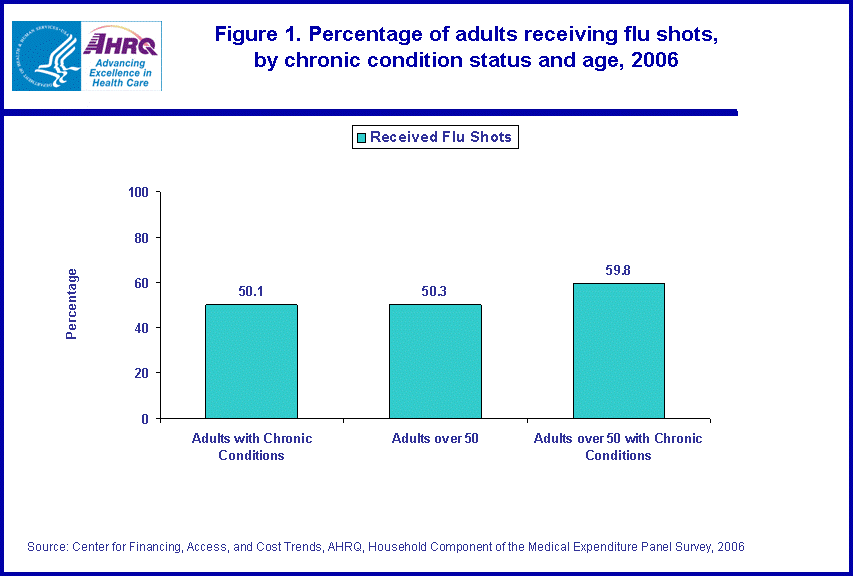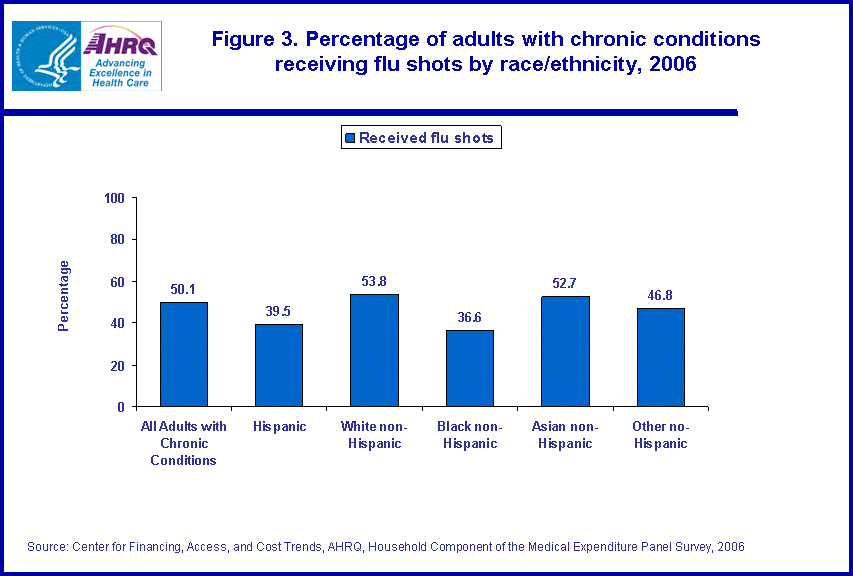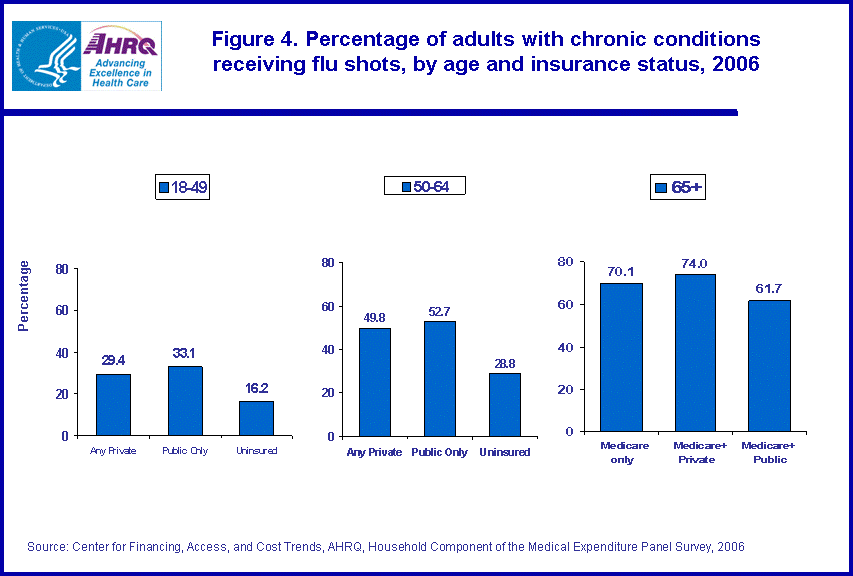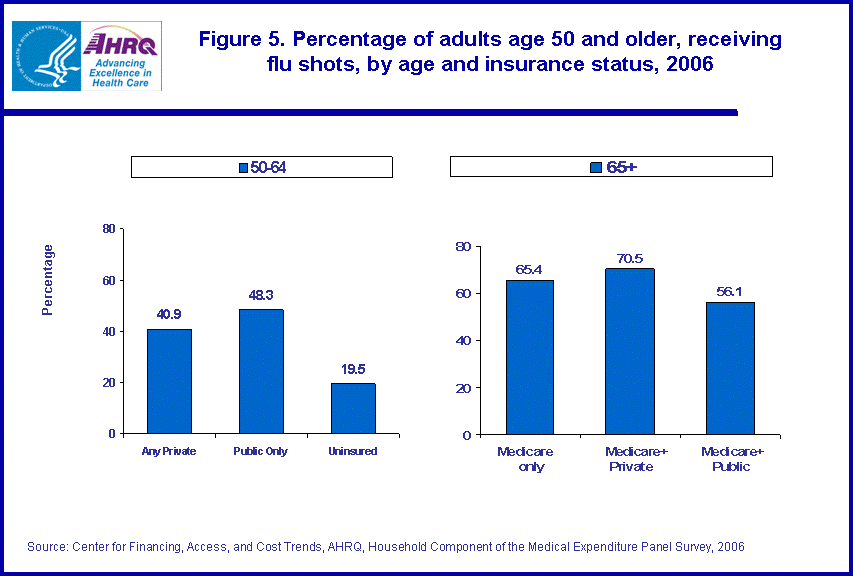
|
|
Font Size:
|
||||
|
|
|
|
||||
STATISTICAL BRIEF #226:
Influenza Immunization Rates for Selected at Risk Populations among the U.S. Adult Civilian Noninstitutionalized Population, 2006
Highlights
- In 2006, only half of adults over 50 years of age and half of all adults with selected chronic health conditions (heart disease, diabetes, asthma, or high blood pressure) reported to have received an influenza immunization within the last year.
- Immunization rates for the most vulnerable population, the elderly 65+ with chronic conditions, were somewhat higher (71.2%); however, even for this population, more than 25 percent did not receive the recommended yearly flu shot.
- Less than one-third (28.1 percent of younger adults (18-49) with chronic conditions) reported to have received a flu shot in the last year.
- Uninsured younger adults (18-49) with chronic conditions had much lower flu shot vaccination rates compared to their privately and publicly insured counterparts (16.2 percent vs. 29.4 percent and 33.1 percent respectively).
- In the near elderly population (50-64) those having private or public health insurance coverage were more than twice as likely to have received a yearly flu shot than those who were uninsured (40.9 percent and 48.3 percent versus 19.5 percent respectively).
Introduction
Influenza (the flu) is a contagious respiratory illness caused by influenza viruses that can cause mild to severe illness. Some people, such as the elderly and people with certain health conditions, are at high risk for serious flu complications. These complications can lead to hospitalization and/or even death. Receiving an influenza immunization would reduce the chance of getting the flu and its complications in most people.
This Statistical Brief analyzes 2006 data of the Household Component of the Medical Panel Expenditure Survey (MEPS-HC) to examine the receipt of annual flu shots for two sub-populations in the adult U.S. civilian noninstitutionalized population at high risk for contracting the flu: persons with selected chronic conditions (see Definitions) and persons over 50 years of age. All comparisons discussed in the text are statistically significant at the .05 level unless otherwise noted.
Findings
Only half (50 percent) of adults over 50 years of age and all adults who reported to have any one or more of selected chronic conditions (heart disease, diabetes, asthma, or high blood pressure) received an influenza immunization in the prior year. The flu shot rate among those with chronic conditions who were age 50 and older, was higher with about 60 percent reporting to have had received influenza immunizations (figure 1).
Among those with chronic conditions, the highest rates of immunizations classified by age were for the elderly (65 and older). More than 70 percent (71.2 percent) of those age 65 and older reported receiving a flu shot within the last year as compared to less than half (48.1 percent) of those between the ages of 50-64 (figure 2).
Among those with chronic conditions, non-Hispanic blacks and Hispanics were much less likely than white non-Hispanic adults to have received an influenza vaccination within the last year (36.6 percent, or 39.5 percent versus 53.8 percent) (figure 3).
The data also indicate some variation in receiving flu shots by insurance status. Among elderly adults (age 65 and older) who reported any of the chronic conditions, those who were covered by Medicare plus some other public insurance were least likely to have received an influenza immunization within the last year (61.7 percent), compared to those covered by Medicare only or Medicare plus some private insurance (70.1 percent and 74.0 percent respectively) (figure 4).
Furthermore, uninsured younger adults (18-49) with chronic conditions had substantially lower influenza vaccination rates compared to their counterparts who were covered by either private or public health insurance (16.2 percent versus 29.4 percent and 33.1 percent respectively). Likewise, among persons 50-64 years of age who had any of the chronic conditions, those who were uninsured were much less likely to have had an influenza immunization within the last year than those who were covered by any private or only public insurance (28.8 percent versus 49.8 percent or 52.7 percent).
The data indicate that insurance coverage was a particularly important factor in whether or not a person obtained a flu shot for the near elderly population (50-64). Less than one fifth (19.5 percent) of uninsured persons between ages 50-64 reported to have received an influenza immunization within the last year. Flu shot rates for the near-elderly covered by health insurance were more than twice as high with 48.3 percent of those covered by only public health insurance and 40.9 percent of those with private insurance reporting that they had received a flu shot (figure 5).
Similar to their counterparts with chronic conditions, in general those over 65 were substantially less likely to get a flu shot if they were covered by Medicare and public coverage (56.1 percent) than if they were covered by either Medicare only (65.4 percent) or Medicare and private coverage (70.5 percent).
Data Source
The estimates shown in this Statistical Brief are drawn from the MEPS-HC public use file HC-105 (2006 Full Year Consolidated Data File).
Definitions/Methodology
Chronic conditions
The indicator for the chronic conditions was drawn from variables indicating the presence of heart disease (coronary heart disease, angina, heart attack, stroke, or any other heart-related disease), diabetes, asthma or high blood pressure. For each of the conditions listed, the following question was asked: "(Have/Has) PERSON ever been told by a doctor or other health professional that PERSON had [condition]."
Racial and ethnic classifications
Classification by race and ethnicity was based on information
reported for each family member. Respondents were asked if each family member
was Hispanic or Latino. Respondents were also asked which race or races best
described each family member. Race categories included white, black/African
American, American Indian or Alaska Native, Asian, Native Hawaiian or other
Pacific Islander, and other. Based on these questions, sample persons were
classified into the following race/ethnicity categories: Hispanic, white
non-Hispanic single race, black non-Hispanic single race, Asian non-Hispanic
single race, and other (Hawaiian/Pacific Islander non-Hispanic, American
Indian/Alaska Native non-Hispanic, and multiple races non-Hispanic).
Health insurance status
Individuals under age 65 were classified into the following
three insurance categories based on household responses to the health insurance
status questions:
- Any private health insurance: Individuals who, at any time during the year, had insurance that provided coverage for hospital and physician care (other than Medicare, Medicaid, or other public hospital/physician coverage) were classified as having private insurance. Coverage by TRICARE (Armed Forces-related coverage) was also included as private health insurance. Insurance that provided coverage for a single service only, such as dental or vision coverage, was not included.
- Public coverage only: Individuals were considered to have public coverage only if they met both of the following criteria: 1) they were not covered by private insurance at any time during the year, and 2) they were covered by one of the following public programs at some point during the year: Medicare, Medicaid, or other public hospital/physician coverage.
- Uninsured: The uninsured were defined as people not covered by private hospital/physician insurance, Medicare, TRICARE, Medicaid, or other public hospital/physician programs at any time during the entire year or their period of eligibility for the survey.
Individuals 65 and older were classified into the following three insurance categories:
- Medicare only: Individuals who, at any time during the year, were covered by Medicare only.
- Medicare plus private: Individuals who at any time during the year, were covered by a combination of Medicare, TRICARE, or private insurance.
- Medicare plus other public coverage: Individuals who, at any time during the year, were covered by Medicare and some other type of public insurance, but had no private coverage.
About MEPS-HC
MEPS-HC is a nationally representative longitudinal survey that collects detailed information on health care utilization and expenditures, health insurance, and health status, as well as a wide variety of social, demographic, and economic characteristics for the civilian noninstitutionalized population. It is cosponsored by the Agency for Healthcare Research and Quality and the National Center for Health Statistics.
For more information about MEPS, call the MEPS information coordinator at AHRQ (301) 427-1656 or visit the MEPS Web site at http://www.meps.ahrq.gov/.
References
For a detailed description of the MEPS-HC survey design, sample design and methods used to minimize sources of non-sampling errors, see the following publications:
Cohen, J. Design and Methods of the Medical Expenditure Panel Survey Household Component. MEPS Methodology Report No. 1. AHCPR Pub. No. 97-0026. Rockville, MD: Agency for Health Care Policy and Research, 1997. http://www.meps.ahrq.gov/mepsweb/data_files/publications/mr1/mr1.shtml
Cohen, S. Sample Design of the 1996 Medical Expenditure Panel Survey Household Component. MEPS Methodology Report No. 2. AHCPR Pub. No. 97-0027. Rockville, MD: Agency for Health Care Policy and Research, 1997. http://www.meps.ahrq.gov/mepsweb/data_files/publications/mr2/mr2.shtml
Cohen, S. Design Strategies and Innovations in the Medical Expenditure Panel Survey. Medical Care, July 2003: 41(7) Supplement: III-5-III-12.
Agency for Healthcare Research and Quality. National Healthcare Quality Report, 2005. Rockville, MD: U.S. Department of Health and Human Services. http://www.ahrq.gov/qual/Nhqr05/nhqr05.htm
Centers for Disease Control and Prevention - Influenza Fact Sheet: Key estimates about Influenza and the Influenza Vaccine. Rev ed. Atlanta, GA: U.S. Department of Health and Human Services, Centers for Disease Control and Prevention: 2006. http://www.cdc.gov/flu/keyfacts.htm
Information about influenza and its prevention: http://www.influenza.com/?utm_source=google&utm_medium=cpc&utm_campaign=Sponsor_Influenza
2008-09 Recommendations of the Advisory Committee on Immunization Practices (ACIP) http://www.cdc.gov/flu/professionals/vaccination/#2008-09recommendations
Suggested Citation
Soni, A. Influenza Immunization Rates for Selected at Risk Populations among the U.S. Adult Civilian Noninstitutionalized Population, 2006. Statistical Brief #226. December 2008. Agency for Healthcare Research and Quality, Rockville, MD, http://www.meps.ahrq.gov/mepsweb/data_files/publications/st226/stat226.shtmlAHRQ welcomes questions and comments from readers of this publication who are interested in obtaining more information about access, cost, use, financing, and quality of health care in the United States. We also invite you to tell us how you are using this Statistical Brief and other MEPS data and tools and to share suggestions on how MEPS products might be enhanced to further meet your needs. Please e-mail us at mepspd@ahrq.gov or send a letter to the address below:
Steven B. Cohen, PhD, Director
Center for Financing, Access, and Cost Trends
Agency for Healthcare Research and Quality
540 Gaither Road
Rockville, MD 20850
 |
||||||||||||||||||||||||||||||||||||||||||||||||
|
||||||||||||||||||||||||||||||||||||||||||||||||
|
|
||||||||||||||||||||||||||||||||||||||||||||||||
 |
||||||||||||||||||||||||||||||||||||||||||||||||
|
||||||||||||||||||||||||||||||||||||||||||||||||
|
|
||||||||||||||||||||||||||||||||||||||||||||||||
 |
||||||||||||||||||||||||||||||||||||||||||||||||
|
||||||||||||||||||||||||||||||||||||||||||||||||
|
|
||||||||||||||||||||||||||||||||||||||||||||||||
 |
||||||||||||||||||||||||||||||||||||||||||||||||
|
||||||||||||||||||||||||||||||||||||||||||||||||
|
|
||||||||||||||||||||||||||||||||||||||||||||||||
 |
||||||||||||||||||||||||||||||||||||||||||||||||
|
||||||||||||||||||||||||||||||||||||||||||||||||
|
|
||||||||||||||||||||||||||||||||||||||||||||||||


